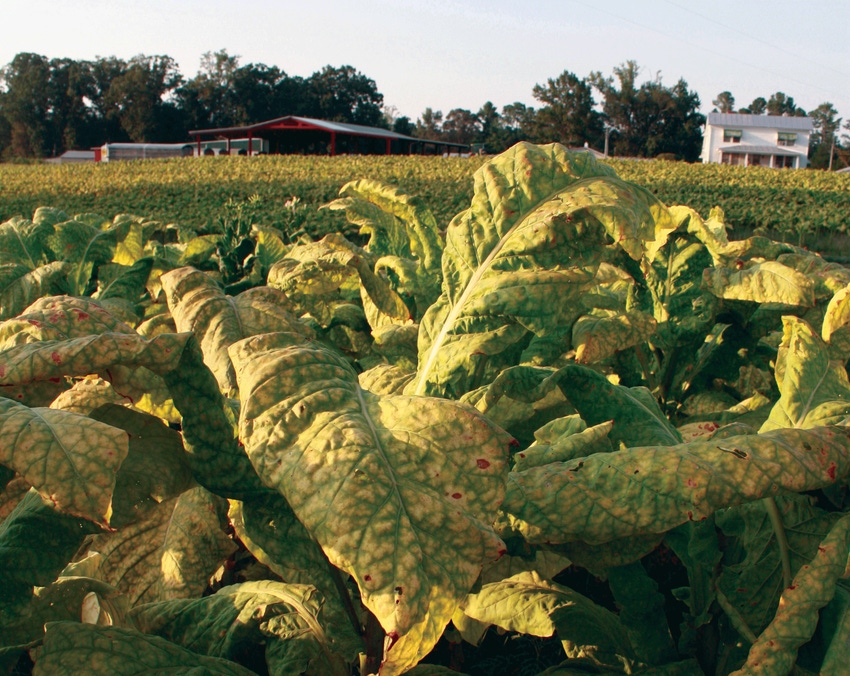November 3, 2016

On David Buchanan’s tobacco farm in the Virginia Piedmont, the weather dealt an unusually problematic hand. As a result, said Buchanan, the 2016 tobacco season proved to be the most difficult in terms of management he had ever experienced.
There were many obstacles to be overcome, but the worst took place right as the growing season began. It had been warm and dry in April and on into May, creating good conditions so that when he started planting, he got off to a quick start.

If you are going to irrigate, be sure to locate your fields where you can easily get to water, said David Buchanan of Skipwith, Va.
If you are going to irrigate, be sure to locate your fields where you can easily get to water, said David Buchanan of Skipwith, Va.But that didn’t last long. “We got half our tobacco planted in early May, then it rained so hard we had to stop,” said Buchanan. “By the time we started again, we had essentially two crops.”
And what was worse, the early planted took off because of the good conditions. The tobacco that got planted in late May and early June grew slowly, making an even greater developmental spread between the two segments.
This was a serious problem, especially in scheduling machinery and workers for any given field, said David Reed, Virginia Extension tobacco specialist. “Farmers would find themselves having to cultivate one field, top another and prime still another, all at the same time. If they were irrigating, that took more than normal management too, and all right when the farmer had the most to do.”
Buchanan, hoped to finish harvesting by the first week of October, but many of his neighbors in Mecklenburg County will harvest much longer.
“I hope we don’t get an early killing frost — one could cause real damage,” he said. “Our tobacco grew so fast early in the season the lower-stalk was really thin.”
But farmers who applied supplemental water were glad they went to the trouble, because it turned very dry in June.
"We are irrigating now to keep it from burning up in the field," said Keith Brankley of Skipwith, Buchanan’s neighbor, in mid-September.
Brankley expects his yield will fall five to 10 percent short on pounds, mainly because some spots got too much water.
Buchanan learned a lesson: If you are going to irrigate, be sure to locate your fields where you can easily get to water. “I had seven ponds and wound up pumping four of them dry,” he said.
Farmers in other Virginia tobacco counties reported similar experiences.
In Pittsylvania County near Danville, Robert Mills of Callands said in September that his flue-cured crop was running late in the field. “We are going to need most of the month of October to finish harvesting.”
There had been a piece of good news earlier at the market. Growers had been discouraged from delivering down-stalk flue-cured leaf. “But there was still a market for good, solid lugs,” he said.
Mills also grows Virginia dark fire-cured. He finished harvesting it in late August. He altered his firing regime in light of the weather. Normally he would fire the barns 10 days after harvest or sooner. But he held off because he didn’t want to affect the humidity. "To this point, the dark tobacco looks really good," said Mills.
In Dinwiddie County, Va., in the north and east corner of the Virginia flue-cured belt, the planting season was very wet, leading to a long developmental lag between the first tobacco planted and the last.
Flue-cured grower Robert Spiers of Stony Creek said he had good weather for most of the growing season, but it got very dry in August. Then it turned wet and rainy in September.
“Now, the tobacco we planted early is doing pretty good,” he said in late September. “But the later tobacco is not getting ripe.”
In Appomattox County, which is toward the northwestern end of the Virginia tobacco belt, it was quite a tough season. “We were excessively wet through layby — and then the rain stopped,” said County Extension Agent Bruce Jones.
The drought wasn’t broken until Sept. 19. “It was the first substantial rainfall in over two months, “Jones said. “Some areas got 2.5 inches.”
There was still much burley and flue-cured tobacco in the field, and most of it ‘greened’ since the rain,” said Jones. Farmers will be harvesting these types for some time.
The county produces dark fire-cured tobacco as well as flue-cured and burley. Harvest of dark was complete in September, with curing proceeding well, he said.
The north end of the Virginia tobacco belt seemed to have had better luck with the weather, said Chris Brown, Franklin County Extension agent. “We got rainfall most of the season and our crop looks good,” he said at the end of September.
The rains had been relatively even at planting so this area didn’t get the big split between the early and late crops seen in much of Virginia. “There was a short stint of hot, dry weather in late July that warranted irrigation, then it was real dry most of this month,” said Brown. “Otherwise, rainfall has been fairly regular since planting.”
Sun-baking is nowhere near as much of a problem as it is to the east, he added.
Harvest was going smoothly, with about 80 percent of the fields harvested as October began, said Brown. “I’m not sure when harvesting will be finished, but very little will be threatened by frost.”
Solar barn saves cost, shortens curing cycle
Buchanan has saved money on his flue-curing costs and shortened his curing cycles with a Solar Eagle curing barn he bought for this season. Built by Long, it uses a built-in solar collector to save fuel, he said. “I save about a day in curing because of the barn’s airflow. It also yellows more evenly due to heat from the collector on the top and sides and yields very good leaf grades.”
The Solar Eagle reduces fuel cost by ‘actively’ drawing fresh air for curing through the barn’s integral solar collector, said Bob Pope, general manager of Long.
“There it is pre-heated before entering the barn’s heat exchanger and reducing the burner’s load, which can be fired by either propane or natural gas. The floor is higher which improves under the tobacco.”
The barn’s solar collector also transfers heat ‘passively’ to the curing chamber by direct conduction through its collector plate. A federal tax credit is available that reduces the Solar Eagle’s cost to less than a standard Long barn. For more information, call Long at 252 641 4796.
About the Author(s)
You May Also Like




